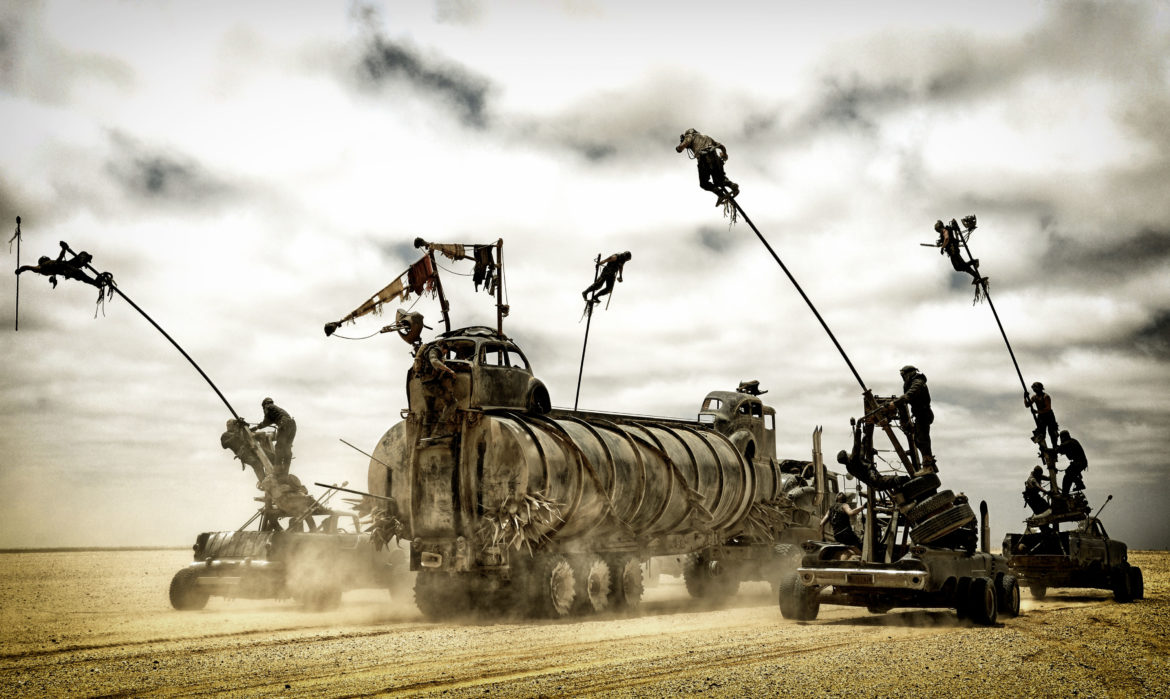Set in the post-apocalyptic world Miller explored in the previous entries in the series (most recently in Beyond Thunderdome – and by recently, I mean 20 years ago), Fury Road seems packed with every idea he’s had in the meantime. With a smart nod to climate change worries – the fundamental resource is now water, not gasoline – and a smart decision to ditch aging anti-Semite Mel Gibson for young Brit Tom Hardy, the movie explodes out of the gate.
One of its key virtues – along with jaw-dropping practical stunts, instantly iconic imagery, and a set of narrative themes that can legitimately be described as feminist – is how much it trusts the audience to go along for the ride without excess exposition. Things will be explained, more or less, but first we have some fucking awesome car chase scenes through the wasteland.
The plot is, by and large, really simple anyway. Tom Hardy’s Max is, as usual, being hunted, this time by agents of the tyrannical Immortan Joe, who rules the land. A nuclear apocalypse of some sort has decimated everything in view, and the people are desperate for water, which Immortan Joe theatrically doles out to maintain total social control. He also maintains a harem of young women for breeding purposes, and a nightmarish wet nurse station that is, for all intents and purposes, a dairy farm. The appropriation of bodies is a recurring theme, from the wet nurses to the use of others as “blood bags” to extend the half-lives of the minions. This is a masculinist, caste-based world, a patriarchy founded on violence and subjugation of bodies.
Imperator Furiosa (Charlize Theron) is in a favored position for the great leader, but has plans of her own. As she heads out on a supply run, she deviates from the course, and it’s revealed she’s transporting the enslaved women to a fabled colony far in the desert. Known as “The Green Place,” it’s said to be somewhere run by women, where women can live in peace and where plants still grow. Immortan Joe does not take kindly to the theft of his female property, and all hell breaks loose as he tries to get them back. Still haunted by all those he’s failed to save over the years, Max becomes enmeshed in their run for freedom as he struggles for his own.
I won’t spoil things further through plot description – suffice to say, things aren’t so simple as getting to The Green Place, and the plan becomes full-on anti-patriarchal insurrection against the state. Miller’s set-pieces dominate the film visually, with armadas of jerry-rigged cars converging on the resistors and doing battle. It’s spectacle at the highest level – gripping, innovative, and clearly-delineated action numbers that are choreographed like a ballet of violence. Compared to something like Michael Bay’s visual mush, Miller and his team have a remarkable ability to make clear what is happening. It’s never confusing, which is an accomplishment given all the different parties converging in violent collision. And all of this is given heart and substance by the performances of Theron and Hardy, and wit by the inclusion of such loving details as the guy who scores sections of the film from the back of a vehicle, blasting metal chords and fire out of his guitar while drummers pound out two-fisted beats.
It was inevitable that there would be some backlash against the film’s celebrated feminism. Notably, Feminist Frequency’s well-regarded Twitter feed categorically claimed it is not feminist – that simply transposing women for men as the inflictors of violence is no victory, and that the camera fetishizes the bodies of the harem as much as it does the explosions and related destruction, implying a masculinist lens even if it seems to be deconstructing the same. It’s a worthwhile point to consider; it’s also just not borne out by the movie. The one scene that most clearly depicts the male gaze in film is a joke on the male gaze in film, and the feminist intent is so overt that it’s barely a subtext at all. As for violence per se? The film seems to think that totalitarian structures demand resistance, and that in a world where you can be crushed and tortured at the whim of others, you’re probably going to have to fight back. Do they enjoy the fighting back? Wouldn’t you? Mad Max: Fury Road is certainly not alone in this view. To its credit, it is firmly on the side of the women (and handful of others) resisting.
As important as those discussions are, though, Mad Max: Fury Road is a movie concerned first and foremost with delivering thrills and indelible images. Which it does, relentlessly and with so much skill that it’s kind of mind-boggling. It should be seen on the biggest screen possible, and, if you like, discussed into the night. It’s the most fun I’ve had at a movie theater in years.

